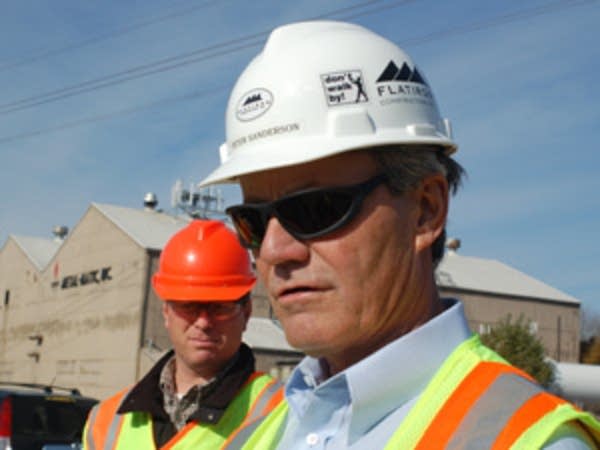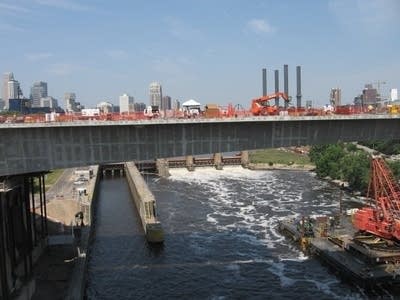I-35W engineer answers concerns about the new bridge

There are bigger and more expensive bridges in the world. However, in Peter Sanderson's more than 35 years of bridge building, none of them have been subjected to the scrutiny given the new I-35W bridge in Minneapolis.
"There's been much more intensive review of this design than I've ever heard of or seen," he said.

Part of the reason for the multiple layers of official inspection and outside evaluation is the unprecedented building schedule.
Sanderson says the new bridge will be done in 11 months from the start of construction around Thanksgiving last year.
Create a More Connected Minnesota
MPR News is your trusted resource for the news you need. With your support, MPR News brings accessible, courageous journalism and authentic conversation to everyone - free of paywalls and barriers. Your gift makes a difference.
Eleven months, Sanderson says, is less than half the usual time of two and a half years for a bridge project this size.
Lots of people want reassurance that construction standards are being met, corners aren't being cut, and the bridge is safe.
Sanderson says Minnesota Department of Transportation inspectors are scrutinizing the construction.
MnDOT has also hired the Parsons Transportation Group, a consulting team, to bring an independent set of eyes to the project.
"There's been much more intensive review of this design than I've ever heard of or seen."
Still, the unprecedented collapse a year ago of the old I-35W bridge has lots of people on edge about the new bridge's safety.
Is the span strong enough to support vehicles on its seven lanes of traffic, and will it support future bus or rail service on an adjacent lane?
To both questions, Peter Sanderson says yes.
That may seem self-serving, but Sanderson has reason to be objective. His reputation is riding on the project.
Another reason is there's at least one lawsuit already filed challenging Flatiron Manson's winning bid for the project.
Flatiron Manson's response to a possible courtroom showdown is to document every step of the bridge building.
Sanderson says even in its unfinished state, the new bridge can support much more weight than the old span.
Here's what he means.

There's speculation the old bridge collapsed in part because of all the construction equipment parked on the deck as the span was being repaired.
Sanderson says the weight of the construction equipment on the new bridge is greater and, at one point, included two cranes each weighing 75 tons.
"We've had two heavy cranes sticking right at the tip of the cantilever before it's even connected in the middle," he said.
Sanderson offers additional assurance. He says the new bridge will be strong enough to withstand something that will never happen -- fully loaded semitrailer trucks, bumper to bumper, on all seven traffic lanes of traffic.
Sanderson says the new span's life expectancy is 100 years, and there are lots of ways, he says, to measure how it's aging.

Sensors built into the bridge will tell inspectors what's happening to the span over time.
"They'll be able to test strains and stress. They'll be able to measure any movement, longitudinally and vertically. They'll be able to tell chloride penetration, the effect of the salt," he said.
Sanderson says every component inside and out can be visually inspected as well.
The total collapse of the old span forced drivers to find alternative routes, a big headache.
However, it meant workers building the new span didn't have to compete with traffic. That speeded the rebuilding, since as many as 650 workers a day could work simultaneously on nearly every facet of building a new bridge.
Another factor allowing fast-track building is the bridge design. Poured concrete was used, instead of steel, to make the 120 box girders for the span.
It would have taken additional months, transportation officials say, to manufacture all of the made to order steel.
The key factor allowing the project to be completed so fast is money.

"If you apply a lot of money you can get things done more quickly," said Sanderson.
The money permitted the hiring of a huge work force to work around the clock, two 12 hour shifts a day, every day of the week.
The decision to build the project fast is expensive. However, transportation and elected officials argue the expense is balanced against the economic wallop from a major bridge being out of service.
Jon Chiglo, the Minnesota Department of Transportation's manager on the bridge project, says taking longer has a huge economic impact in lost business, business delayed, congestion and increased commuting times among other costs.
"We estimated that the road user costs to having this bridge out of service is approximately $400,000 a day," he said.
By that calculation, Chiglo says, building the bridge in 11 months versus two and a half years saves at least $240 million.
If that arithmetic is correct, why not fast track other big Minnesota road and bridge construction projects, such as the Crosstown Commons project in south Minneapolis?
The three-and-a-half year construction time for rebuilding the Crosstown interchange is causing lots of delays for commuters and businesses.
State Rep. Bernie Lieder, DFL-Crookston, is the chair of the House Transportation Committee. He says he is all for spending more money to expedite projects, if it means reducing the economic consequences caused by disrupted traffic.
However, Lieder, an engineer by training, says the problem is the strategy can't be used on all projects, including the rebuilding of the Crosstown.

"They couldn't shut down that whole area, because there are too many different roads coming in there. The impact is different," Lieder said. "Here they had a detour, and they could shut it down, and they could work."
State Rep. Alice Hausman, St. Paul-DFL, and chair of the powerful House Capital Investment or bonding committee, agrees.
But Hausman wants to see if a fast-track strategy can be applied to the proposed Central Corridor light rail project along University Ave. between St. Paul and Minneapolis. If funding falls into place, construction on Central Corridor will last four years.
"For all those businesses along that corridor that would have to wait from 2010 to 2014 during a construction phase, there's obviously a lot of economic damage potential there," she said.
Officials put the pricetag for the new I-35W bridge in Minneapolis at $235 million. Total cost of the entire project, including demolition of the old bridge, cleanup and related costs, is more than $400 million.
Nearly $372 million in federal dollars are paying most of the cost. State dollars account for most of the rest.

